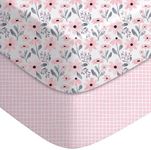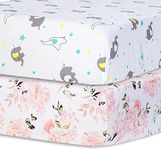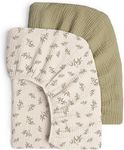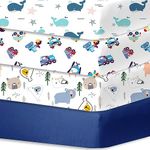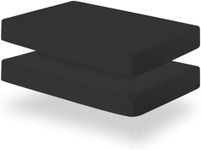Buying Guide for the Best Baby Crib Sheets
Choosing the right baby crib sheets is important for your baby's comfort and safety. The right sheets can help your baby sleep better and make it easier for you to keep the crib clean. When shopping for crib sheets, you should focus on a few key features that affect how well the sheets fit, how comfortable they are, and how easy they are to care for. Understanding these features will help you pick the best crib sheets for your baby's needs.MaterialMaterial refers to the fabric the crib sheet is made from, and it plays a big role in how soft, breathable, and durable the sheet is. Common materials include cotton, organic cotton, bamboo, and polyester blends. Cotton is soft, breathable, and gentle on sensitive skin, making it a popular choice. Organic cotton is similar but grown without chemicals, which some parents prefer for sensitive babies. Bamboo is naturally hypoallergenic and very soft, while polyester blends can be more affordable and wrinkle-resistant. If your baby has sensitive skin or allergies, natural materials like organic cotton or bamboo may be best. If you want something easy to wash and quick to dry, a cotton-polyester blend might suit you.
Fit and SizeFit and size refer to how well the sheet matches the dimensions of your crib mattress. Most crib sheets are designed to fit standard crib mattresses, but it's important to check the measurements. A good fit means the sheet is snug and doesn't come loose, which is important for your baby's safety. Sheets that are too loose can bunch up and create a suffocation risk, while sheets that are too tight may be hard to put on. Always measure your crib mattress and compare it to the sheet's size. If you have a non-standard crib or a mini crib, look for sheets specifically made for those sizes.
Elastic EdgesElastic edges refer to the stretchy band sewn around the edge of the sheet, which helps it stay securely on the mattress. Some sheets have elastic only at the corners, while others have elastic all the way around. Full elastic edges provide a more secure fit and are less likely to pop off during the night. If you want peace of mind that the sheet will stay in place, look for sheets with elastic all the way around the edge.
Thread CountThread count is the number of threads woven into one square inch of fabric. A higher thread count usually means a softer and more durable sheet, but for crib sheets, extremely high thread counts are not always necessary. Sheets with a thread count between 200 and 400 are usually soft and comfortable for babies. If you want a balance of softness and breathability, aim for a moderate thread count. Very high thread counts can sometimes make sheets less breathable, which may not be ideal for babies.
Ease of CleaningEase of cleaning refers to how simple it is to wash and dry the crib sheets. Babies can be messy, so you'll want sheets that can handle frequent washing without shrinking, fading, or losing their softness. Check the care instructions before buying. Cotton and polyester blends are usually easy to wash and dry, while some specialty fabrics may require more delicate care. If you want to save time and effort, choose sheets that are machine washable and can go in the dryer.
Hypoallergenic PropertiesHypoallergenic properties mean the sheet is less likely to cause allergic reactions or irritate sensitive skin. Materials like organic cotton and bamboo are naturally hypoallergenic and are a good choice if your baby has allergies or eczema. If your baby has sensitive skin or you have a family history of allergies, look for sheets labeled as hypoallergenic.
Design and ColorDesign and color refer to the look of the crib sheet, including patterns, prints, and shades. While this doesn't affect function, it can be important for matching your nursery decor or creating a soothing environment for your baby. Some parents prefer neutral colors for a calm look, while others like bright patterns for visual stimulation. Choose a design that fits your style and makes you happy when you see your baby's crib.




